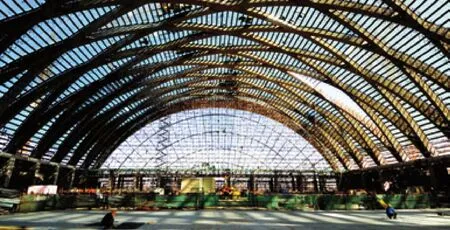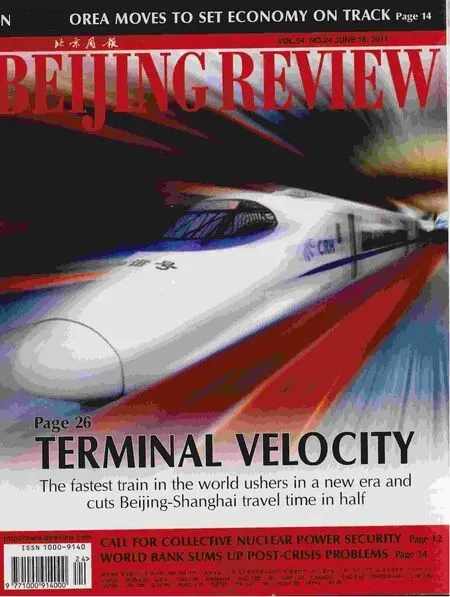A Golden Artery
2011-10-14ByLANXINZHEN
By LAN XINZHEN
A Golden Artery
By LAN XINZHEN
The Beijing-Shanghai High-Speed Railway will be an important transportation link between the country’s two major economic centers
A month before the Beijing-Shanghai High-Speed Railway is officially launched, Mei Yonghong, Mayor of Jining, Shandong Province, is busy motivating local government officials to prepare for the opportunities the rail corridor will bring to his city.
Jining is located near the Qufu Station on the line, the hometown of Confucius. Jining will utilize all available resources in tandem with the new high-speed link to promote and develop the region’s tourism industry, Mei said.
“The shortened travel time will prompt more travelers from big cities like Beijing and Shanghai to visit Jining on the weekends and during holidays,” Mei said. “We’re sure to see more tourists because of the railway.”
Jining is not alone in anticipating the rewards it will benefit from as a result of the Beijing-Shanghai High-Speed Railway.Local governments of cities along the line are all gearing up for opportunities.
The Beijing-Shanghai High-Speed Railway, linking China’s two most vibrant and promising economic centers, the Bohai Sea Economic Rim and the Yangtze River Delta, will surely propel economic growth and employment in these areas along the line(see pages 32-33), said Xu Fengxian, a research fellow with the Chinese Academy of Social Sciences.
The current Beijing-Shanghai rail line is one of the busiest routes in the country.With more than a quarter of the country’s population living in the regions along the route—Beijing, Tianjin, Hebei Province,Shandong Province, Anhui Province,Jiangsu Province and Shanghai—the passenger and freight volumes currently account for 10.2 percent and 7.2 percent of the country’s total, respectively. Of China’s total railway mileage, this line accounts for only 2 percent.
“The limited passenger and freight transportation capacity of the current railway between Beijing and Shanghai has slowed exchanges between the two economic centers,” said Wang Zhitai, Deputy Director of the China Society of Logistics.
The two economic circles, Wang said,boast different advantages. The Bohai Sea Economic Rim is close to China’s primary coal-producing area. Shanghai, located in the Yangtze River Delta, has advanced financial and service industries. To date,interaction between the two centers has been handicapped by an inefficient logistics capacity, which the high-speed railway will address.
When the new high-speed railway opens,the existing line running parallel to it will be used as a freight line with an annual capacity of 130 million tons, easing transport pressures along the route.
With 90 pairs of trains in service a day,the Beijing-Shanghai High-Speed Railway will be able to transport 80 million passengers a year in one direction, said the Ministry of Railways.
By linking the Bohai Sea Economic Rim and the Yangtze River Delta, the two most dynamic regions in China, the high-speed railway will effectively cut logistics costs between the two regions, said Zhao Hong,Deputy Director of the Economy Research Institute of the Beijing Academy of Social Sciences.
In addition, the new high-speed railway will provide passengers with an access to other means of transportation. Shanghai Hongqiao, where the Shanghai terminal of the railway is located, is a large transportation hub in Shanghai and even the whole Yangtze River Delta, consisting of an airport, a railway station and subway and bus terminals.
In the long run, the high-speed railway will also promote urban and rural planning and the development of modern transportation hubs, Zhao said. He estimates the railway’s operation can increase the GDP of the areas along the line by 20 percent.
Sun Xiaofei, a researcher with the Beijing-based Samsung Economic Research Institute China, said the high-speed railway will accelerate the urbanization of areas along the line. It can meet the increasing demand of passenger and cargo transportation brought by urbanization.
It will also be conducive to the establishment of trans-regional city clusters. Cutting the travel time in half, the cities along the line will be connected more closely than before, allowing labor and information resources to be allocated more effectively, said Sun. What’s more, industrial transfer and upgrading will be accelerated.

MOVING ON: The waiting hall at Tianjin West Railway Station is expected to come into operation in June 2011. The station is one of five key terminals along the Beijing-Shanghai High-Speed Railway
